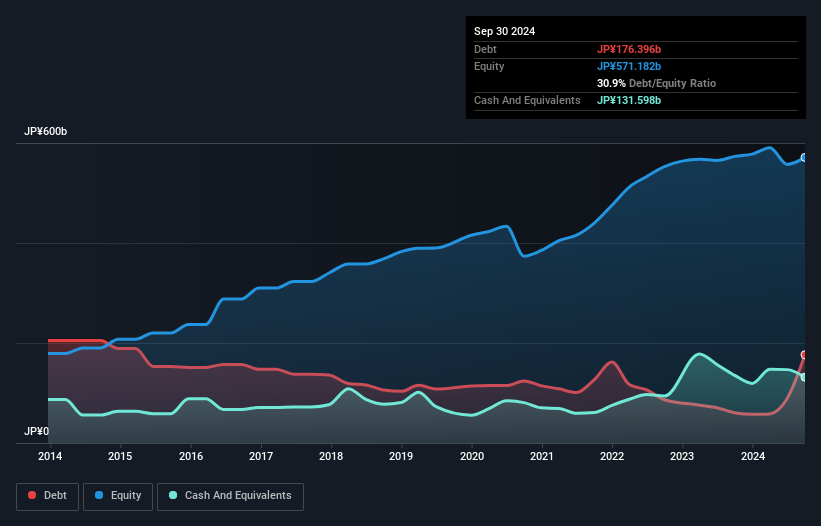Here's Why SG HoldingsLtd (TSE:9143) Can Manage Its Debt Responsibly
David Iben put it well when he said, 'Volatility is not a risk we care about. What we care about is avoiding the permanent loss of capital.' So it seems the smart money knows that debt - which is usually involved in bankruptcies - is a very important factor, when you assess how risky a company is. We note that SG Holdings Co.,Ltd. (TSE:9143) does have debt on its balance sheet. But should shareholders be worried about its use of debt?
When Is Debt A Problem?
Debt assists a business until the business has trouble paying it off, either with new capital or with free cash flow. If things get really bad, the lenders can take control of the business. However, a more usual (but still expensive) situation is where a company must dilute shareholders at a cheap share price simply to get debt under control. Of course, plenty of companies use debt to fund growth, without any negative consequences. The first step when considering a company's debt levels is to consider its cash and debt together.
View our latest analysis for SG HoldingsLtd
How Much Debt Does SG HoldingsLtd Carry?
You can click the graphic below for the historical numbers, but it shows that as of September 2024 SG HoldingsLtd had JP¥176.4b of debt, an increase on JP¥60.7b, over one year. However, it also had JP¥131.6b in cash, and so its net debt is JP¥44.8b.

How Strong Is SG HoldingsLtd's Balance Sheet?
The latest balance sheet data shows that SG HoldingsLtd had liabilities of JP¥341.0b due within a year, and liabilities of JP¥118.8b falling due after that. Offsetting this, it had JP¥131.6b in cash and JP¥203.1b in receivables that were due within 12 months. So it has liabilities totalling JP¥125.1b more than its cash and near-term receivables, combined.
Given SG HoldingsLtd has a market capitalization of JP¥920.1b, it's hard to believe these liabilities pose much threat. But there are sufficient liabilities that we would certainly recommend shareholders continue to monitor the balance sheet, going forward.
We use two main ratios to inform us about debt levels relative to earnings. The first is net debt divided by earnings before interest, tax, depreciation, and amortization (EBITDA), while the second is how many times its earnings before interest and tax (EBIT) covers its interest expense (or its interest cover, for short). Thus we consider debt relative to earnings both with and without depreciation and amortization expenses.
SG HoldingsLtd has a low net debt to EBITDA ratio of only 0.35. And its EBIT easily covers its interest expense, being 195 times the size. So you could argue it is no more threatened by its debt than an elephant is by a mouse. But the bad news is that SG HoldingsLtd has seen its EBIT plunge 18% in the last twelve months. We think hat kind of performance, if repeated frequently, could well lead to difficulties for the stock. When analysing debt levels, the balance sheet is the obvious place to start. But ultimately the future profitability of the business will decide if SG HoldingsLtd can strengthen its balance sheet over time. So if you want to see what the professionals think, you might find this free report on analyst profit forecasts to be interesting.
Finally, a company can only pay off debt with cold hard cash, not accounting profits. So we always check how much of that EBIT is translated into free cash flow. During the last three years, SG HoldingsLtd produced sturdy free cash flow equating to 70% of its EBIT, about what we'd expect. This cold hard cash means it can reduce its debt when it wants to.
Our View
Happily, SG HoldingsLtd's impressive interest cover implies it has the upper hand on its debt. But we must concede we find its EBIT growth rate has the opposite effect. All these things considered, it appears that SG HoldingsLtd can comfortably handle its current debt levels. On the plus side, this leverage can boost shareholder returns, but the potential downside is more risk of loss, so it's worth monitoring the balance sheet. When analysing debt levels, the balance sheet is the obvious place to start. But ultimately, every company can contain risks that exist outside of the balance sheet. Case in point: We've spotted 1 warning sign for SG HoldingsLtd you should be aware of.
When all is said and done, sometimes its easier to focus on companies that don't even need debt. Readers can access a list of growth stocks with zero net debt 100% free, right now.
New: Manage All Your Stock Portfolios in One Place
We've created the ultimate portfolio companion for stock investors, and it's free.
• Connect an unlimited number of Portfolios and see your total in one currency
• Be alerted to new Warning Signs or Risks via email or mobile
• Track the Fair Value of your stocks
Have feedback on this article? Concerned about the content? Get in touch with us directly. Alternatively, email editorial-team (at) simplywallst.com.
This article by Simply Wall St is general in nature. We provide commentary based on historical data and analyst forecasts only using an unbiased methodology and our articles are not intended to be financial advice. It does not constitute a recommendation to buy or sell any stock, and does not take account of your objectives, or your financial situation. We aim to bring you long-term focused analysis driven by fundamental data. Note that our analysis may not factor in the latest price-sensitive company announcements or qualitative material. Simply Wall St has no position in any stocks mentioned.
About TSE:9143
SG HoldingsLtd
Through its subsidiaries, is involved in the delivery, logistics, real estate, and other businesses in Japan and internationally.
Good value average dividend payer.
Market Insights
Community Narratives



